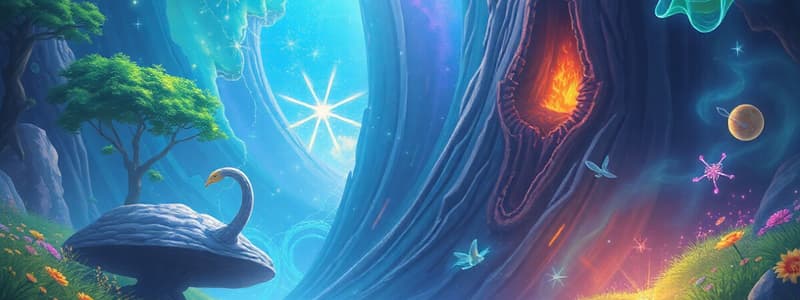Podcast
Questions and Answers
What did John Needham challenge regarding the origin of life?
What did John Needham challenge regarding the origin of life?
- The belief that life arises from other living organisms
- The idea that boiling can eliminate microorganisms (correct)
- The theory of cellular basis of life
- The concept of autotrophs and heterotrophs
Which characteristic of living things indicates that they cannot survive independently?
Which characteristic of living things indicates that they cannot survive independently?
- Adaptation to the environment
- Interaction with the environment (correct)
- Cellular basis of life
- Reproduction and inheritance
How do autotrophs obtain their energy?
How do autotrophs obtain their energy?
- By generating heat through metabolism
- By performing photosynthesis (correct)
- By absorbing nutrients from soil
- By consuming other organisms
What important role do cells play in living organisms?
What important role do cells play in living organisms?
Which of the following best describes how biodiversity has arisen?
Which of the following best describes how biodiversity has arisen?
What concept does not accurately represent the relationship between living and non-living things?
What concept does not accurately represent the relationship between living and non-living things?
Which statement about cellular functions is incorrect?
Which statement about cellular functions is incorrect?
Which aspect of living organisms is essential for their survival in changing environments?
Which aspect of living organisms is essential for their survival in changing environments?
What is the primary mechanism through which traits are inherited by the next generation?
What is the primary mechanism through which traits are inherited by the next generation?
Which of the following does not describe a function of autotrophs?
Which of the following does not describe a function of autotrophs?
Flashcards
Spontaneous Generation
Spontaneous Generation
The belief that living organisms can arise from non-living matter.
Cell
Cell
The basic unit of life, all living things are made of them.
Form and Function
Form and Function
An organism's structure is designed to match its job or purpose.
Interdependence
Interdependence
Signup and view all the flashcards
Homeostasis
Homeostasis
Signup and view all the flashcards
Biogenesis
Biogenesis
Signup and view all the flashcards
Needham's Experiment
Needham's Experiment
Signup and view all the flashcards
What is the basis of life?
What is the basis of life?
Signup and view all the flashcards
How do structures and functions relate?
How do structures and functions relate?
Signup and view all the flashcards
Passing Down Traits
Passing Down Traits
Signup and view all the flashcards
Study Notes
Introduction to Life Science
- Life science is the study of living things
- Lesson topics include the concept of life, theories of the origin of life, and unifying themes of life
- Learning outcomes include discovering the origin of life, learning about unifying themes of life, and creating an ecosystem
Concept of Life
- Life is defined as any system capable of performing functions like eating, metabolizing, excreting, breathing, moving, growing, reproducing, and responding to external stimuli
- Life properties include a definite form and limited size, a limited lifespan, being made up of one or more cells, using only chemical energy, and having adaptation
Characteristics of Life
- Nutrition: Metabolism, the sum total of chemical reactions in an organism
- Movement: Ability of an organism to move
- Respiration: Anabolism, building up process
- Excretion: Process of removing waste and excess water from the body
- Growth: Increase in size and number
- Sensitivity: Ability to respond to environmental stimuli
- Reproduction: Ability of living things to produce new individuals closely resembling them
Two Types of Cell Organisms
- Unicellular Organisms: Made up of a single cell that carries out all necessary functions (e.g., Paramecium, Amoeba, Bacteria, Yeast)
- Multicellular Organisms: Use many different cells to function (e.g., Insects, Humans, Plants)
Theories on the Origin of Life
-
Special Creation Theory: Life was created by a divine being or supernatural power
-
Spontaneous Generation Theory: Living organisms arise from non-living things
- Francesco Redi (1668): Experiment disproved spontaneous generation of maggots, showing they came from fly eggs
- John Needham (1745): Challenged Redi's work, arguing boiling could kill microorganisms
- Lazzaro Spallanzani: Designed experiments showing only exposed broth produced microorganisms
- Louis Pasteur: Further experiments disproved spontaneous generation, demonstrating contamination came from the air
-
Other Theories:
- Beneath the Ice: Ice protected early compounds, allowing interaction to create life
- Lightning: Produced simple sugars and amino acids from simple elements
- Panspermia: Life came from outer space
- RNA World Theory : RNA was the first genetic material
Unifying Themes of Life
- Biological Systems: Living things function as an integrated system that cannot be separated from non-living things
- Cellular Basis of Life: Cells are the fundamental units of life
- Form and Function: Organism's structures fit with its functions
- Reproduction and Inheritance: Traits of parents are passed to offspring
- Interaction with the Environment: Survival depends on interactions with the environment
- Energy and Life: Organisms use energy for processes; autotrophs use photosynthesis, and heterotrophs consume other organisms
- Regulation/Homeostasis: Maintaining a stable internal environment
- Adaptation: Ability to adjust to changing environments, fundamental to survival
- Evolution: Change over time, leading to biodiversity
- Biology and Society: Science changes the lives of organisms, impacts medicine, agriculture, environment, humans
- Further study considers how modern biology changes everyday human life
Studying That Suits You
Use AI to generate personalized quizzes and flashcards to suit your learning preferences.




